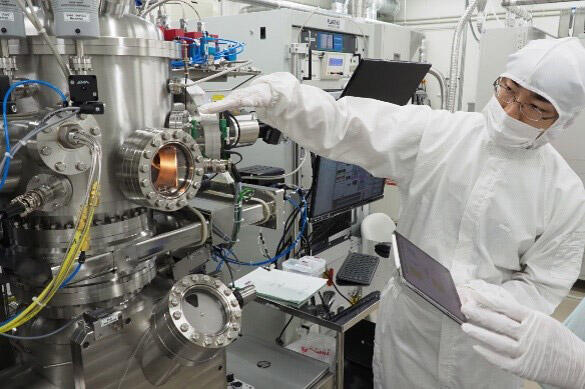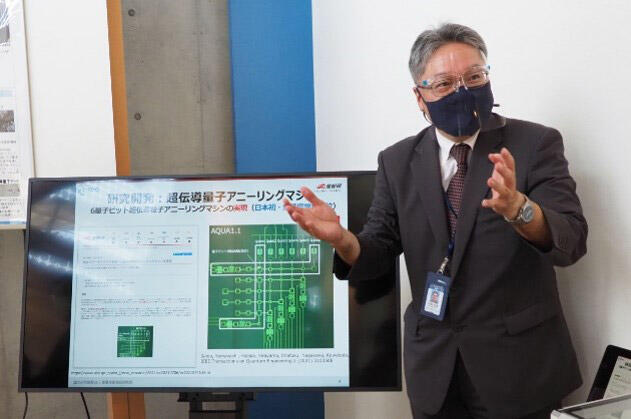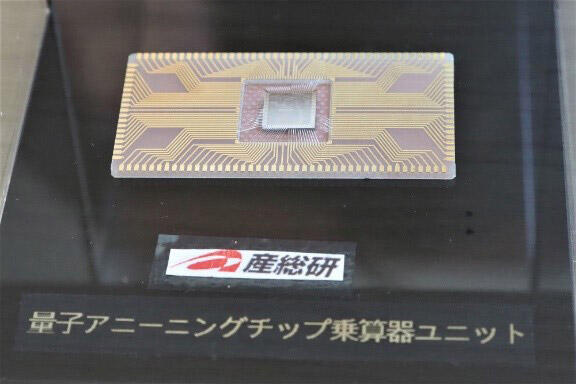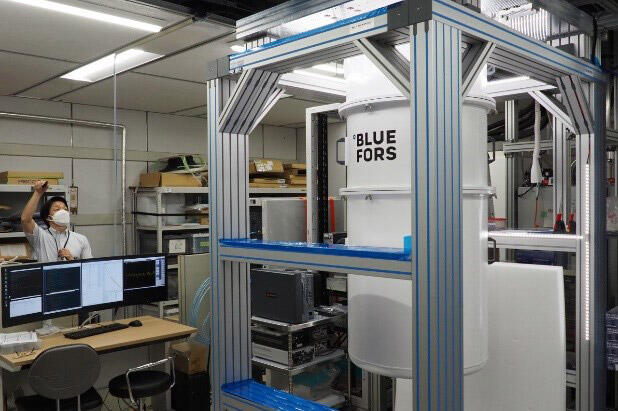Last year's Nobel Prize in Physics was awarded to three researchers from the United States and Europe who have made significant achievements in the field of quantum physics, which is the study of the atoms and electrons that make up matter. These researchers are also key players in the foundation of information technologies that will lead to the dream of a "quantum computer." With industry-academia-government efforts on this front also continuing in Japan, the National Institute of Advanced Industrial Science and Technology (AIST) and the New Energy and Industrial Technology Development Organization (NEDO) briefed the press on the state of development and opened their research and development center to the public. An individual involved with the effort said that, "A quantum computer will take years to develop, but it will be 'blazing fast' and have a tremendous impact on society the moment it is completed."
Limited strengths, but expected to have a wide range of applications
At the end of September, Yuki Hayashi, the Director of the Internet of Things Promotion Department, NEDO, spoke to the press at the AIST center in Tsukuba City, Ibaraki Prefecture. "As we move toward an Internet of Things (IoT) society, the amount of information will continue to increase, but we are reaching the limit of what can be achieved by simply miniaturizing semiconductors with existing technologies. We expect that quantum computers and quantum annealing machines will be fundamental technologies for realizing innovative information processing."
Conventional computers represent data as 0s and 1s according to the level of voltage applied to the semiconductor, and they operate in binary. Their basic unit is the "bit". Quantum computers, on the other hand, are based on the mysterious properties of quantum mechanics, in which quanta can be superimposed on each other, and use a state in which 0s and 1s can simultaneously exist, which allows them to parallelize large numbers of calculations. Their basic unit is the "qubit". It is said that quantum computers have the potential to perform high-speed calculations that far surpass the abilities of existing supercomputers.

Quantum annealing machines are a type of quantum computer that are specialized for "combinatorial optimization problems," such as finding the shortest route from a large number of routes. The term "annealing" comes from the process of stabilizing the structure of a metal by heating it and then slowly cooling it. Quantum annealing uses quantum-mechanical fluctuations instead of thermal fluctuations to search for the optimal low-energy state. The principle was proposed in 1998 by Specially Appointed Professor Hidetoshi Nishimori at the Tokyo Institute of Technology.
For example, when a salesman needs to find the shortest route to travel to multiple cities, it isn't that difficult as long as the number of cities is small, but the number of possible answers exponentially increases as the number of cities increases and it becomes exceedingly difficult to find the shortest route via a brute force method (Travelling salesmen problem). It is expected that quantum annealing machines will be invaluable for problems like this.
As computers that are based on the principles of quantum mechanics, both quantum computers and quantum annealing machines are expected to be applied to a wide range of fields, including drug discovery, materials development, artificial intelligence, and finance.
Shiro Kawabata, Deputy Director of the Research Center for Emerging Computing Technologies, AIST, explained that, "Quantum computers are still at a pretty basic stage, and they won't be ready tomorrow. Some people say it will be 20 or 30 years at the earliest, or even longer. The types of problems that quantum computers are good at are very limited. However, they can solve important problems that are spread over a wide range of industrial fields and can do so at 'blazing speed.' The moment that quantum computers are developed, they will have a disruptive impact on the industrial world."

International competition intensifies - Japan also paying attention
Through a NEDO project, AIST has been focusing on research and development of quantum annealing machines with Hitachi and others since FY2016. In July last year, AIST announced that, in collaboration with Yokohama National University, it had succeeded in developing Japan's first quantum annealing machine. While the Canadian venture company D-Wave Systems, which was the first in the world to commercialize a quantum annealing machine in 2011, and others are leading the way, the unique mechanism of AIST's quantum annealing machine lets it solve problems with about an order of magnitude fewer qubits than conventional methods. This has the advantage of making it easier to handle large-scale problems.
Currently, as a NEDO "Research and Development of Innovative Annealing Machines for Combinatorial Optimization" project (project will run up to FY2027), in collaboration with NEC and others, AIST has been working on research and development centered around quantum annealing, but which also includes quantum computers.

In 2020, D-Wave Systems brought to market a commercial quantum annealing machine with around 5,600 qubits. However, according to Deputy Director Kawabata, with this level of performance, it can handle the traveling salesman problem for 10 cities at most. For actual use in society, he said, large-scale integration on the order of one million qubits is essential. In terms of quantum computers, IBM in the U.S. created a 128-qubit quantum computer last year, but has said that it will take 20 to 30 years to achieve the one million qubit level that is required for practical usage. "Qubit integration is still orders of magnitude too small. We still need long periods of research and development," he said.
With intensifying international competition and IBM, Google, Intel, and others setting strategic goals for the development of quantum computers, Japan has also been working to achieve these goals, and additionally is continuing to work on industry-academia-government such as through the Ministry of Education, Culture, Sports, Science and Technology's Quantum Leap Flagship Program (Q-LEAP) (project will run up to FY2029) and the Cabinet Office's Moonshot Research & Development Program, which will be headed by the Japan Science and Technology Agency (JST) and which aims to "realize a fault-tolerant general-purpose quantum computer that will dramatically advance economy, industry, and security by 2050." A "fault-tolerant general-purpose quantum computer" is the ultimate form of a quantum computer that is highly integrated on a large scale, and which exhibits sufficient accuracy for a variety of applications.
In April 2022, the government compiled a "Quantum Future Society Vision" that aims to use quantum technologies to transform society.
Cryogenics, automatic measurement are trump cards for accelerating development
AIST briefed the press on a series of developments and unveiled the latest equipment at the center. One of the items shown off was a refrigerator for evaluating the performance of quantum computers and quantum annealing machines at the extremely low temperatures, close to absolute zero, that are required for these machines to work. It was introduced from a Finnish company and is being used to evaluate prototypes.

While the CPU (central processing unit) of familiar personal computers performs both control and computation, these two functions are separated in a quantum computer. Therefore, currently the chip that performs the calculations is placed in the refrigerator and a large control unit, that is connected by cables to the calculation chip, stands right next to the refrigerator. Therefore, AIST is now developing a "cryo-CMOS integrated circuit," a small chip with control functions. If realized, the system will become more compact and power efficient.
As a trump card to increase the pace of research and development, AIST also introduced a "prober" that, at cryogenic temperatures, automatically and continuously inspects the performance of devices on wafers (substrates) with a diameter of 300mm. Conventional equipment for doing this is small, divides the wafer into sections, and manually inspects devices one by one. The introduction of this new prober, which is designed for large-scale integration, has increased speed over 100 times. The new prober is expected to demonstrate its effectiveness in the development of transistors, which are the basic elements of cryo-CMOS integrated circuits.

Right: A 300mm diameter wafer
Also displayed were quantum annealing chips that have been manufactured and one of the largest clean rooms in Japan, which was constructed with a dedicated set of equipment. Deputy Director Kawabata said, "Research and development is progressing step by step worldwide in order to reach the ultimate goal of a 'fault-tolerant general-purpose quantum computer.' Just like in a relay race, it is important to pass on the technological baton and continue for a long time."
This is indeed a long-term effort toward practical application, and the researchers will probably change from generation to generation. By visiting AIST's facilities, I got a glimpse of the steady efforts that are being made to bring about the future of society. Quantum mechanics are full of mysteries, and, to be completely honest, are difficult to understand, but while continuing to study the field, I want to also keep an eye on the future research and development, which also has Japan's industrial competitiveness at stake.
(KUSAKA Takeo / Science Portal Editorial Office)
Original article was provided by the Science Portal and has been translated by Science Japan.




